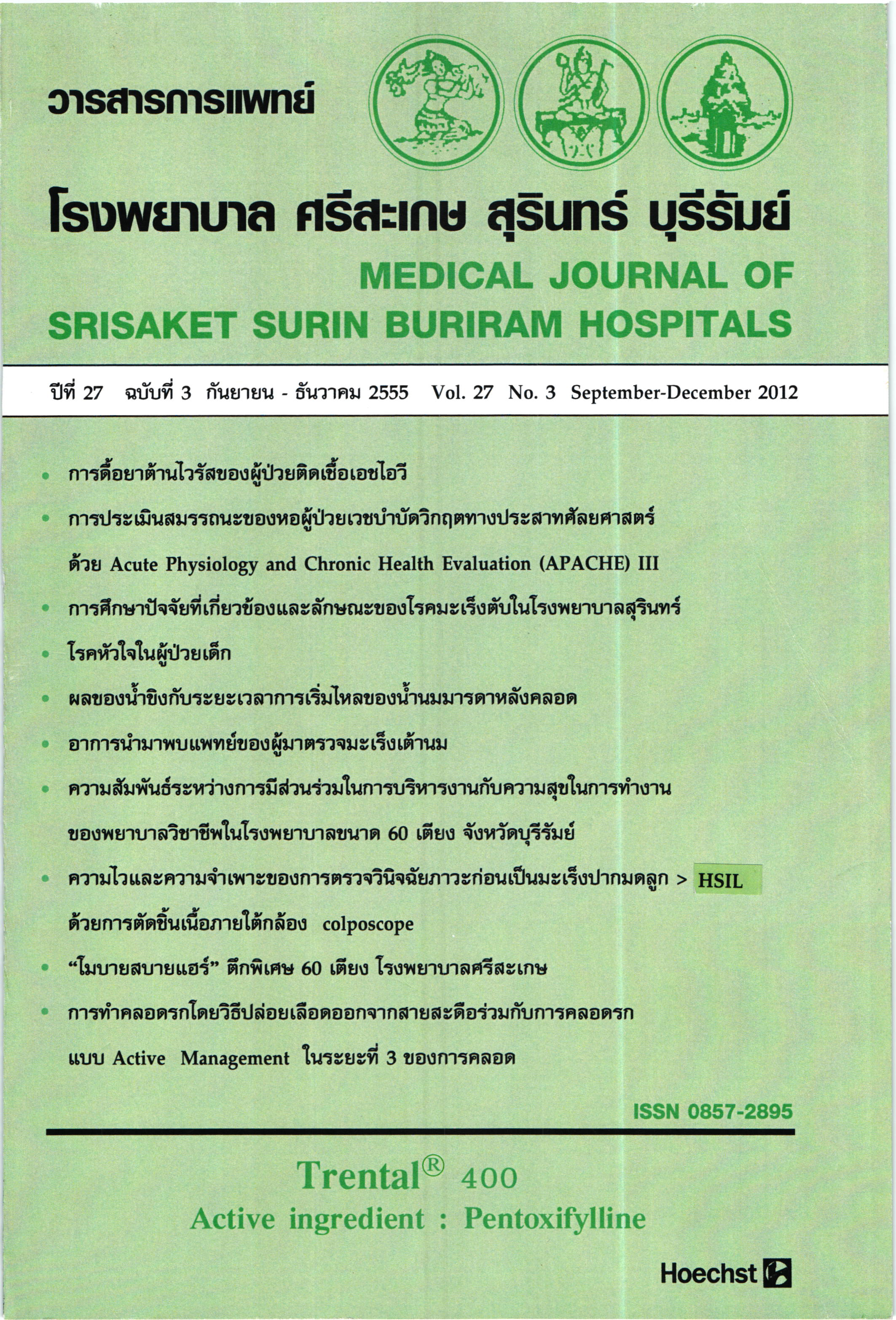การทำคลอดรกโดยวิธีปล่อยเลือดออกจากสายสะดือร่วมกับการคลอดรก แบบ Active Management ในระยะที่ 3 ของการคลอด
Main Article Content
บทคัดย่อ
เหตุผลของการศึกษา: ภาวะตกเลือดหลังคลอดเป็นปัญหาสำคัญทางสาธารณสุขของทุกประเทศทั่ว โลกโดยเฉพาะ ในประเทศกำลังพัฒนา เนืองจากเป็นภาวะแทรกซ้อนที่พบมากและเป็นและเป็นสาเหตุที่ทำให้เกิด ทุพพลภาพและเพิ่มอัตราการตายของมารดา สาเหตุเกิดจาก การคลอดที่เนิ่นช้า ครรภ์แฝด ทารก ตัวโต มารดามีภาวะซีด ครรภ์เป็นพิษและการใช้หัตถการช่วยคลอด และที่สำคัญเกิดจากกระบวนการ คลอดที่ไม่ได้มาตรฐานซึ่งสามารถป้องกันได้ วัตถุประสงค์: เพื่อเปรียบเทียบ ปริมาณเลือดที่ออกหลังคลอด ภาวะตกเลือดหลังคลอด เวลาการคลอดระยะที่ 3 ความเข้มข้นของเลือดหลังคลอดระหว่างระหว่างกลุ่มที่คลอดรกโดยวิธี active management รวมกับการปล่อยเลือดออกจากสายสะดือ,กลุ่มทีคลอดรกโดยวิธี active management ร่วมกับ การหนีบสายสะดือ และ กลุ่มที่คลอดรกโดยวิธี expectant management
รูปแบบการศึกษา: เป็นการศึกษาเชิงทดลอง (Clinical Randomized Controlled Trial)
ประชากรและกลุ่มตัวอย่าง: หญิงตั้งครรภ์ครบกำหนด ที่มาคลอดในโรงพยาบาลสุรินทร์ตั้งแต่ 1 กุมภาพันธ์พ.ศ. 2555 ถึง 30 เมษายน พ.ศ. 2555 จำนวน 150 ราย แบ่งออกเป็น 3 กลุ่ม กลุ่มละ 50 ราย
วิธีการศึกษา: จับฉลากลุ่มเข้าเป็นกลุ่มตัวอย่าง สุ่มจับสลากที่มีรหัสอยู่ภายในซองทึบสีน้ำตาลเพื่อคัดเลือกกลุ่ม ตัวอย่าง เข้ากลุ่มทดลองหรือกลุ่มควบคุมเจาะเลือดเพื่อส่งตรวจหาความเข้มข้นของเลือดแรกรับ ให้การดูแลตามมาตรฐานปกติของห้องคลอดจนกระทั่งคลอดในกลุ่มควบคุมให้การดูแลในระยะที่ 3 แบบ expectant management กลุ่มทดลองกลุ่มที่ 1 ให้การดูแลแบบ active management ร่วมกับการหนีบสายสะดือ กลุ่มทดลองกลุ่มที่ 2 ให้การดูแลในระยะที่ 3 แบบ active management ร่วมกับการปล่อยเลือดออกจากสายสะดือ ประเมินผลลัพธ์ ของการคลอด ปริมาณเลือดที่ออก หลังคลอด ภาวะตกเลือดหลังคลอด ระยะเวลา การคลอดระยะที่ 3ระดับความเข้มข้นของเลือด หลังคลอด
การวิเคราะห์ข้อมูล: วิเคราะห์ค่าเฉลี่ยของเวลาการคลอดระยะที 3 จำนวนการสูญเสียเลือดภายหลังคลอด และค่าความเข้มข้นของเลือด ระหว่างกลุ่มโดยการวิเคราะห์ความแปรปรวน (ANOVA) เปรียบเทียบ ความแตกต่างของ ภาวะตกเลือดหลังคลอด ระหว่างกลุ่มโดยการวิเคราะห์ไคสแควร์ Chi-square test วิเคราะห์ข้อมูลทั่วไปโดยใช้สถิติความถี่ ร้อยละ ค่าเฉลี่ย ส่วนเบี่ยงเบนมาตรฐาน
ผลการศึกษา: พบว่าค่าเฉลี่ยระยะเวลาของการคลอดที่ 3 จำนวนการสูญเสียเลือดหลังคลอด ของทั้งสามกลุ่ม แตกต่างกันอย่างมีนัยสำคัญทางสถิติทีระดับ p<.05 แต่ระดับความแตกต่างของค่าความเข้ม ข้นของเลือดหลังคลอด ภาวะตกเลือดหลังคลอดผลลัพธ์ไม่แตกต่างกันทางสถิติ p>.05
สรุป: การดูแลในระยะที่ 3 แบบ active management ร่วมกับการคลายสายสะดือ เป็นวิธีการที่สะดวก ง่ายต่อการบริหารจัดการ ควรนำรูปแบบการดูแลดังกล่าวมาปรับเป็นแนวทางปฏิบัติ ในการดูแลผู้คลอด เพื่อให้การคลอดปลอดภัย
คำสำคัญ: ตกเลือดหลังคลอด
Article Details
References
2. World Health Organization. Managing Complications in Pregnancy and Childbirth. Geneva: World Health Organization; 2000.
3. World Health Organization. Pregnancy, Childbirth, Postpartum and Newborn Care: A Guide for Essential Practice. 2nd ed. Geneva:World Health Organization; 2005.
4. Nagaya K, Fetters MD, Ishikawa M, Kubo T, Koyanagi T, Saito Y, et al. Causes of maternal mortality in Japan. JAMA 2000; 283:2661-7.
5. World Health Organization. The World Health Report 2005. France : Keith Wynn; 2005.
6. Prendiville WJ, Elbourne D, McDonald S. Active versus expectant manage¬ment in the third stage of labour (Cochrane Review). In: The Repro¬ductive Health Library. Oxford Update Software Ltd, Issue 3; 2000.
7. Prendiville WJ, ElbourneD, McDonaldS. Active versus expectant management in the third stage of labour (Cochrane Review). In: The Cochrane Library, Oxford: update softwareIssue 1; 2002.
8. Giacalone PL, Vignal J, Daures JP et al. A Randomized evaluation of two techniques of management of third stage of labour in women at low risk of postpartum hemorrhage. British Journal of Obstetric Gynecology 2000; 107: 396-400.
9. Gulani N, Chauhan MB, Rana M. Placental blood drainage in management of third stage of lobour. Journal of Obstetric Gynecology India 2001; 51: 46-8.
10. Dildy III GA. Postpartum hemorrhage: new management options. Clinical Obstetric Gynecoy 2002; 45: 330-44.
11. ACOG educational bullentin. Postpar turn hemorrhage. International Journal of Gynecology Obstetric 2004; 243: 79-86.
12. Soltani H, Dickinson F, Symonds I. Placenta cord drainage after spontaneous vaginal delivery as part of the third stage of labour. Cochrane Data base Systematic review 2005; 4: CD004665.
13. Sharma JB, Pundir P, Malhotra M, Arora R. Evaluation of placental drainage as a method of the placental delivery in vaginal delivery. Arch Gynecology Obstetric 2005; 271: 343-5.
14. Shravage JC, Silpa P. Randomized Controlled Trial of placental cord drainage for the prevention of post partum hemorrhage. The Journal of Obstetrics and Gynecology of India; 2008: 213-5.
15. PiphatJongkolsiri and Saknan Mano-taya. Placental cord drainage and the effect the duration of third stage labour, A Randomized controlled Trial. Journal Medical Association Thai; 2009, 92: 456-60.

